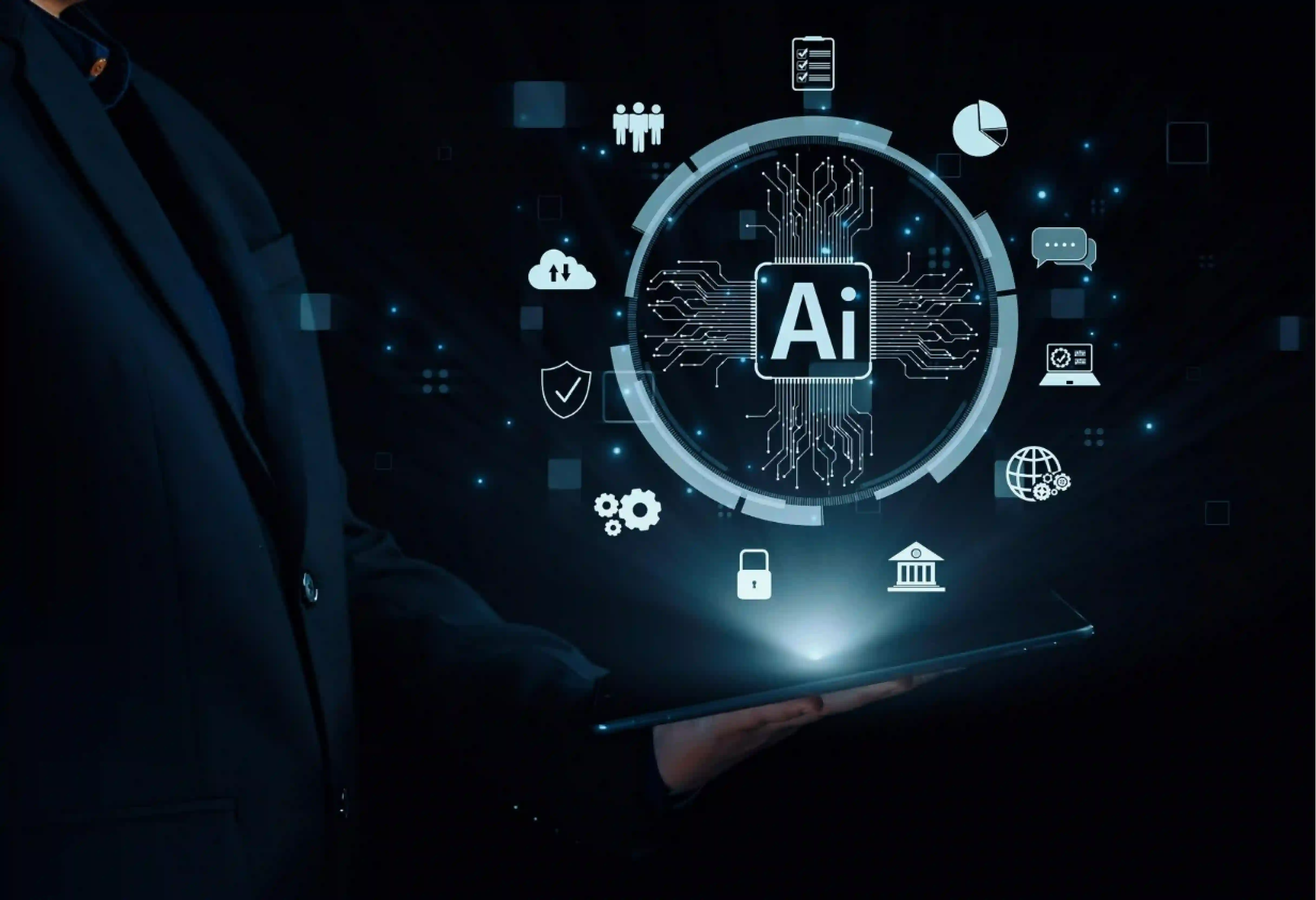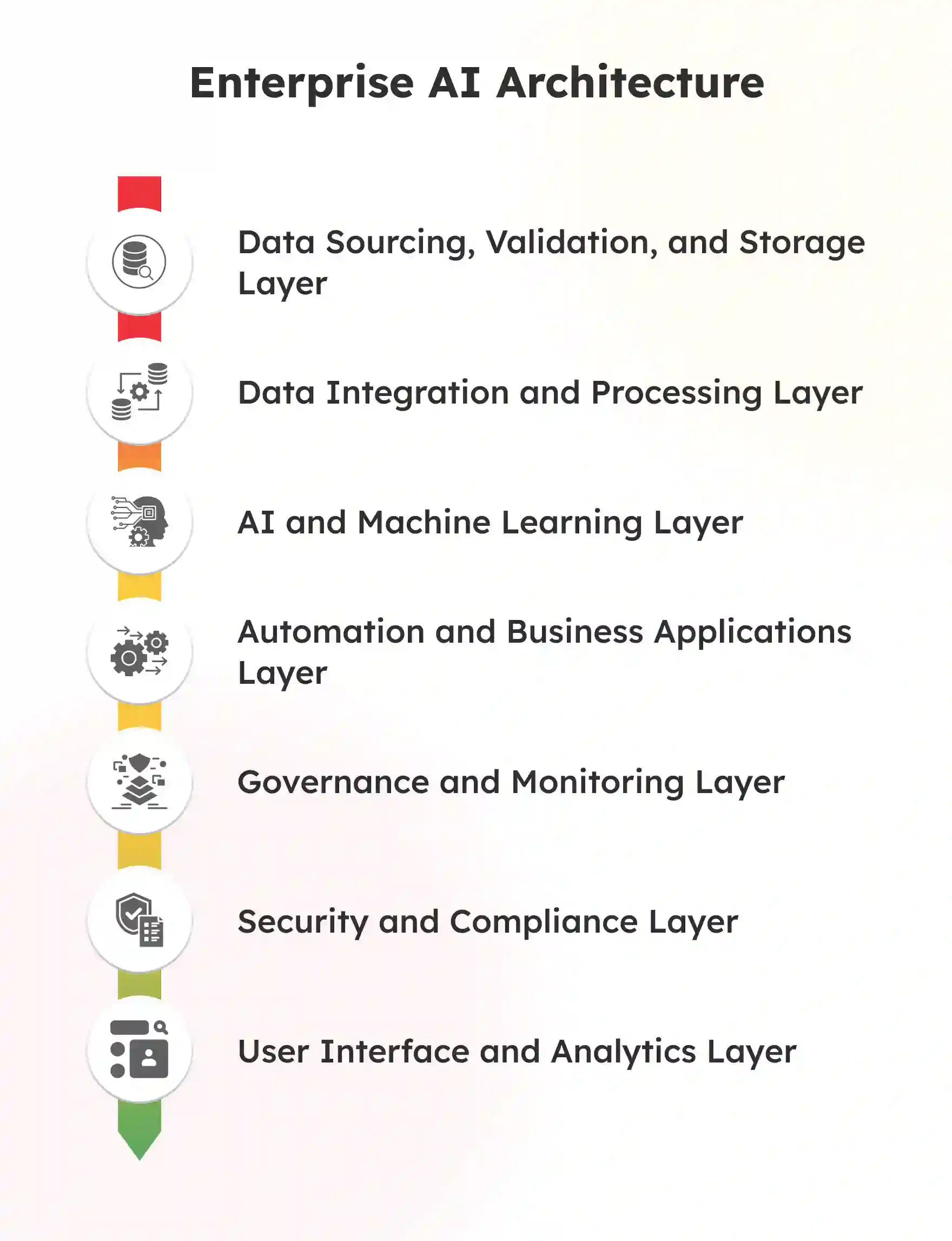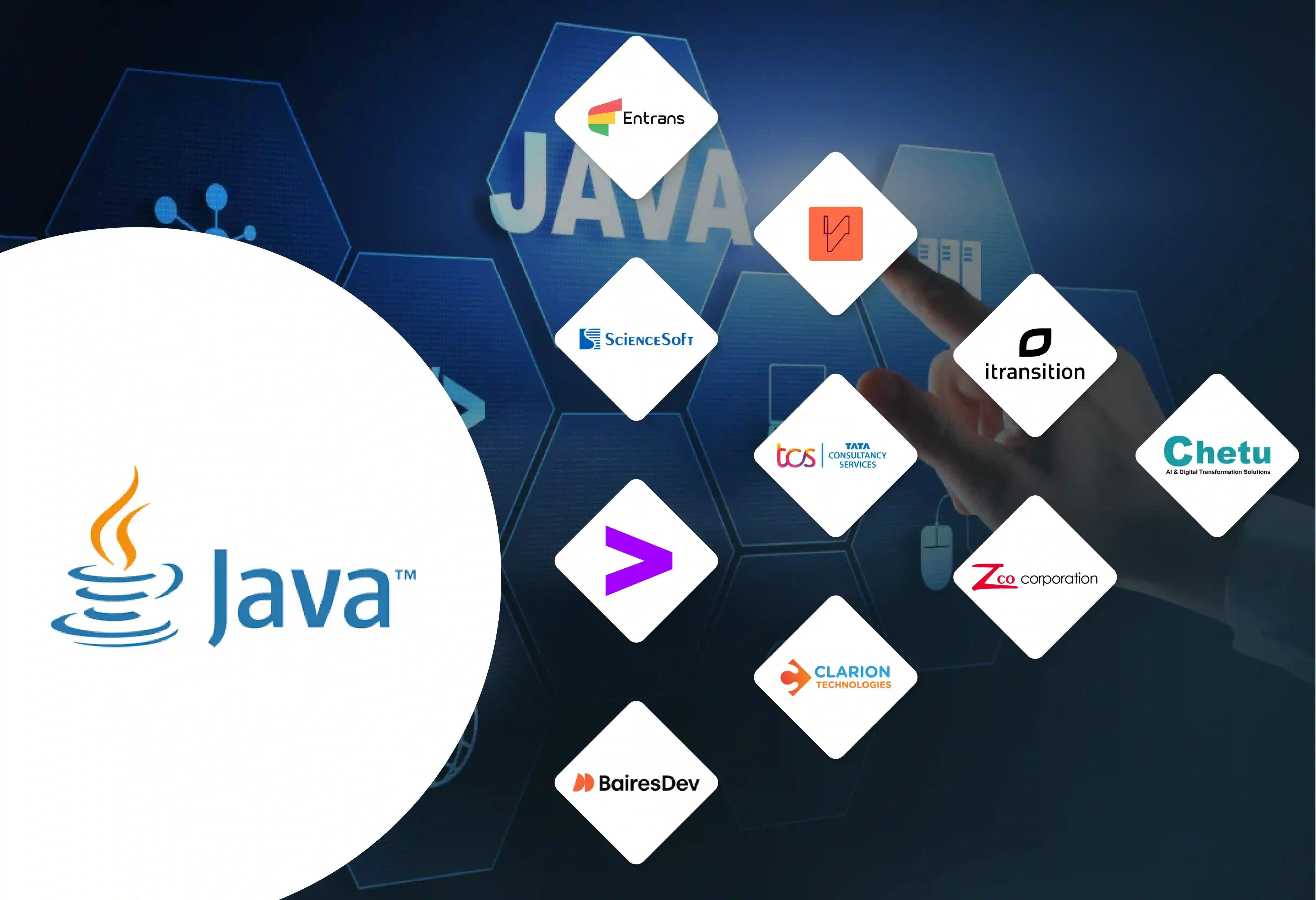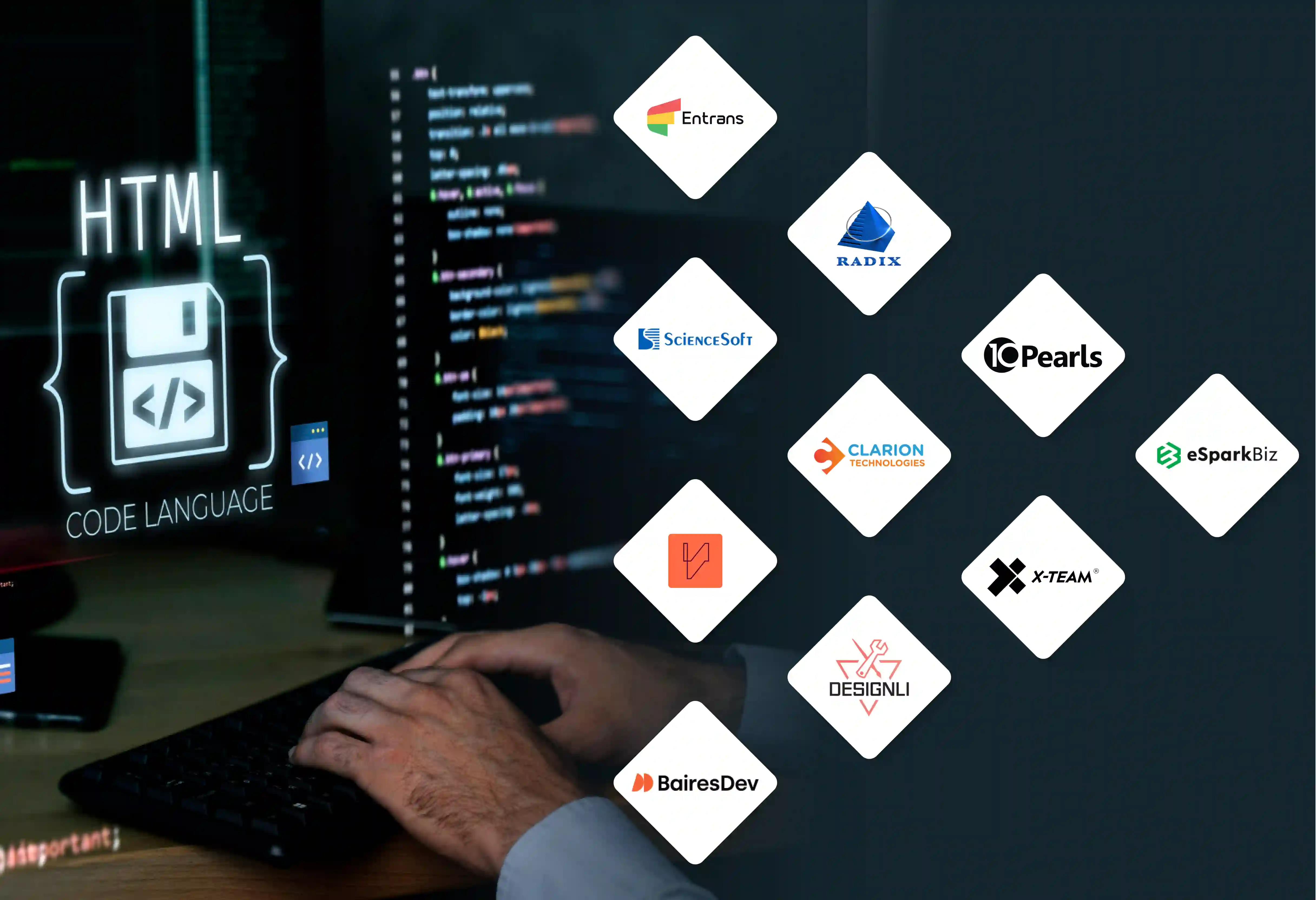


Whether it's for predictive analytics, real-time analytics, or frameworks that use enterprise proprietary data, Enterprise AI architecture is now irreplaceable. That said, smooth carrying out is essential yet challenging for varied industries and applications.
Scalability with MLOps and cloud infrastructure adds efficiency and value for businesses. However, when implemented incorrectly, it can lead to data silos and machine learning algorithms that are expensive despite no value.
AI Architecture is expensive, so we’ll walk you through the key components and the best practices to follow in this article. Is AI Architecture worth it? Absolutely! And we’ll show you how it should be done.
Enterprise AI Architecture is a framework that integrates AI throughout the organization's infrastructure and databases to drive business outcomes, reporting, and automation.
Typically, AI enterprise architecture, unlike consumer AI or niche-specific is a lot more scalable and does not limit itself to one function and outcome. Enterprise AI is also integrated with multiple platforms and databases across multiple departments and systems.
Ideally, in Enterprise architecture, you aim to create a system using machine and deep learning algorithms to predict enterprise performance and monitor data, operations, and compliance with industry best practices.


The data layer in enterprise AI architecture is responsible for ingesting information from disparate sources - including databases, IoT sensors, and third-party APIs - and ensuring its integrity. This is also reinforced with automated data quality checks to identify and resolve anomalies. Parallel intelligent data cataloging is used in this layer to track lineage and provenance.
Secure and scalable storage, whether on-premises or in the cloud, is what makes cleansed data accessible for downstream processing and analysis.
With this, by prioritizing data hygiene and governance, enterprises can build a solid foundation. This can help them get AI-driven insight and decision-making which would be hard to spot or be highlighted if done otherwise.
Extracting value from enterprise data requires sophisticated integration and processing capabilities. That’s why this layer in enterprise AI architecture uses AI-powered ETL (extract, transform, load) pipelines to automate extracting, harmonizing, and enriching information from diverse sources.
To help get it done, machine learning models continuously learn to identify and resolve data quality issues.
Alongside this, Intelligent data cataloging and lineage tracking ensure trustworthy provenance, meaning more reliable and accurate data. This processed data is then staged in a unified, analytics-ready repository for it to be fed into AI models and business applications.
Predictive models are trained, deployed, and continuously optimized to power intelligent capabilities. In this enterprise AI architecture layer, there’s a combination of supervised, unsupervised, and reinforcement learning techniques used to extract these insights and metrics.
This leads to automating decisions and forecasting future outcomes based entirely on your results thus far.
Deep neural networks excel at unstructured challenges like natural language processing and computer vision. Model governance and responsible AI practices ensure these models are reliable, transparent, and ethical.
This layer in enterprise AI architecture serves as the interface between the underlying AI models and the end-users who rely on them.
Natural language processing allows a team of technicians or virtual assistants to handle customer inquiries a lot more efficiently. It also enables computer vision to inspect products for defects and highlight any technical issues as and when they’re spotted. This helps optimize the overall user experience with a lot less need for busy work.
On the other hand, you also have predictive analytics to forecast demand, optimize supply chains, and mitigate risks.
This layer in enterprise AI architecture also has process automation that streamlines repetitive tasks. This frees up employees to focus on higher-value work and initiatives. By infusing AI enterprise architecture throughout their operations, enterprises can boost productivity and enhance decision-making, enabling better client and customer experiences.
The governance and monitoring layer in enterprise AI architecture establishes the policies, standards, and controls to help make sure everything runs without any technical or compliance issues. Put in simple words, it deals with the deployment of AI systems that monitor performance and ethical compliance across the organization.
Part of this is done by centralized AI centers to oversee model performance tracking, fairness auditing, and explainability analysis. Alongside this, you also have automated alerts to flag issues like model drift, data quality problems, and potential biases. This helps indicate when human intervention is required to oversee some regulation or see whether the information is actually accurate or in the right place.
With detailed logging and audit trails, thorough incident response and regulatory compliance becomes a whole lot easier. But on the whole, proactive governance and monitoring are both essential for building trust in enterprise AI.
The security and compliance layer deploys advanced cybersecurity to protect sensitive information and AI enterprise architecture systems from attacks. To do this, automated vulnerability scanning, access controls, and anomaly detection shield against data breaches and adversarial AI assaults.
Alongside this, regulatory compliance frameworks ensure AI-powered decisions, workflows, and outputs adhere to industry guidelines. This is typical for legal and industry regulations around privacy, ethics, and risk management.
In this enterprise AI architecture layer, comprehensive logging and auditing enable thorough incident response and forensics. This means you have a full idea of the different issues or breaches that happen to help prevent them from recurring.
By prioritizing security and compliance, enterprises can trust their AI-driven insights and avoid costly system failures or legal penalties in the long run.
The user interface and analytics layer create human-facing experiences that help employees and customers have a comfortable experience when interacting with the AI that you set up.
This in generative AI enterprise architecture is done through Intuitive dashboards and visualization that deliver data-driven insight in an easy-to-consume format. Natural language processing powers conversational interfaces that handle queries and provide intelligent assistance.
Predictive analytics predict future outcomes and recommend optimal courses of action. Advanced forecasting, simulation, and what-if analysis tools enable strategic decision-making.
Personalized, AI-powered recommendations, nudges, and automation enhance productivity and the user experience. By designing seamless, insight-driven interactions, enterprises can maximize their value using generative AI enterprise architecture data visualization.
The collaboration and customization tools layer provides the interfaces and capabilities for users to build, deploy, and refine AI-powered applications. No-code/low-code platforms enable citizen developers to quickly assemble intelligent workflows and chatbots using generative AI enterprise architecture systems.
AI model training and tuning tools put advanced machine learning in the hands of domain experts. Integrated development environments (IDEs) and AI API marketplaces accelerate the creation of custom AI-driven features.
Enterprise AI architecture must be engineered for scale and flexibility to keep pace with evolving business needs. Modular, microservices-based designs allow for rapid integration of new data sources, AI models, and application layers.
Standardized APIs and low-code/no-code tools empower citizen developers to customize intelligent workflows and features.
The Enterprise AI architecture must be tightly aligned with the organization's strategic objectives, whether that's enhancing the customer experience, boosting operational efficiency, or driving innovation.
By designing for scalability and customization from the outset, enterprises can future-proof their AI enterprise architecture investments and maximize their return.
Harnessing the full potential of enterprise AI architecture processes requires a well-defined, efficient lifecycle management approach. Integrated MLOps (machine learning operations) pipelines automate the training, testing, deployment, and monitoring of AI models in production limiting the requirement for manual intervention.
Aside from this, automated feature engineering, data preparation, and model tuning accelerate the innovation process. Continuous performance tracking and model retraining ensure reliable, up-to-date predictions. Centralized model governance and reproducibility tools maintain compliance, enable collaboration, and mitigate risks.
Responsible enterprise AI hinges on robust governance and an unwavering commitment to ethical practices. Centralized AI centers of excellence establish standardized policies, controls, and guardrails to ensure consistent, fair, and transparent deployment of intelligent systems.
Automated model fairness audits, explainability analysis, and bias mitigation techniques uphold principles of non-discrimination. Comprehensive data governance frameworks protect individual privacy and maintain compliance with industry regulations. Proactive monitoring, incident response, and human oversight processes foster accountability.
As enterprise AI becomes mission-critical, securing data, models, and infrastructure is of paramount importance. Multi-layered cybersecurity measures, including access controls, anomaly detection, and automated vulnerability patching, shield against data breaches and adversarial attacks.
Comprehensive logging, auditing, and incident response capabilities enable thorough forensics and regulatory compliance. AI enterprise architecture security tools monitor model integrity, detect poisoning, and ensure the reliability of mission-critical predictions.
Building a successful enterprise AI architecture is complex, and the stakes are high.
A flawed approach wastes your investment, creates data chaos, and leaves you trailing far behind your competitors.
Entrans has already built its own enterprise AI agent, Thunai which was awarded ‘Product of the Day’ on Product Hunt with over 1300 followers.
Also, did we mention we did this from PoC to product launch in under 6 months?
Your business can't afford an AI system that fails to deliver real value.
With Entrans Technologies as your expert partner, we’ll design custom, scalable AI enterprise architecture for you in record time.
Want to know more? Book a free consultation call!
The main difference is in their scale, data sources, and business integration. General AI often uses public data for isolated, specific tasks, whereas enterprise AI is deeply integrated with a company's proprietary data from its CRMs and ERPs. Enterprise AI is designed for continuous, automated deployment across an entire organization to achieve strategic business goals.
Centralized AI architecture, Federated AI architecture, Cloud-native architecture, On-premises architecture, and edge AI architecture are a few AI architecture types implemented in companies and enterprises.
MLOps refers to machine learning operations which are a fundamental building block of enterprise AI architecture. MLOps automates the deployment and monitoring of machine learning models ensuring that AI systems are scalable and with the least amount of manual intervention possible.
The ideal choice depends entirely on a company's specific goals and existing infrastructure. However, modern systems often use a scalable and flexible architecture like a data lakehouse, which combines the raw data capacity of data lakes with the structured analytics of data warehouses. Ultimately, the most effective architectures are modular, cloud-native, and designed to support the entire MLOps lifecycle seamlessly.
By 2025, enterprise AI architecture has become a competitive necessity for businesses to automate operations and extract deep insights from their vast amounts of data. The maturity of MLOps and the explosive growth of generative AI have made large-scale deployment more feasible and highly valuable for driving innovation.
It's a specialized framework built to support large-scale generative models, such as Large Language Models (LLMs). This architecture includes standard enterprise AI components but adds massive computational power and robust pipelines for model fine-tuning and prompt management. This uses proprietary company data to create new content, power advanced chatbots, or automate complex creative and analytical tasks.
In healthcare, AI architecture helps in transforming and automating several medical processes, data processing, generating, and computing cast amounts of data from Electronic Health Records (EHR). Aside from this, it also helps with medical imaging, medical coding, and seamless integration across internal systems.
The computational and cost impact is significant, demanding major investment in both advanced infrastructure and specialized talent. The high costs come from powerful computing resources like GPUs, sophisticated MLOps software, massive data storage, and the recruitment of highly skilled engineers. While expensive, a well-designed architecture is built to maximize ROI.
Enterprise architecture artifacts are documents that describe an organization's systems and processes. The six common types of artifacts document the business (strategy maps), data (data flow diagrams), applications (interface designs), technology (network diagrams), governance (policies and standards), and implementation (project roadmaps).
Lorem ipsum dolor sit amet, consectetur adipiscing elit, sed do eiusmod tempor incididunt ut labore et dolore magna aliqua. Ut enim ad minim veniam, quis nostrud exercitation ullamco laboris nisi ut aliquip ex ea commodo consequat. Duis aute irure dolor in reprehenderit in voluptate velit esse cillum dolore eu fugiat nulla pariatur.
Block quote
Ordered list
Unordered list
Bold text
Emphasis
Superscript
Subscript






